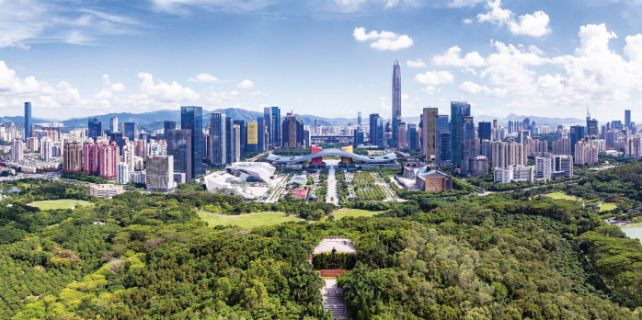Shenzhen plans future with cutting-edge tech
 |
|
Growing from a small fishing town four decades ago, Shenzhen is now one of the main innovation hubs in China. Zhan Yan/Xinhua |
Shenzhen, a southern metropolis that used to be a small fishing town four decades ago, has become legendary for its transformation into a renowned innovative city boasting cutting-edge technologies and strong industries.
The GDP of the city in Guangdong province has soared from 1.3 trillion yuan ($181.1 billion) in 2012 to more than 3 trillion yuan in 2021, ranking it third among Chinese mainland cities, official figures showed.
In 1980, when the city was selected as one of China's four special economic zones, its GDP was just 270 million yuan.
Two Shenzhen-based companies were added to the latest list of Fortune Global 500 in 2022, bringing the city’s total number of such companies to 10. It was three in 2012 — Ping An Insurance, Huawei and China Merchants Bank.
Developing strategic emerging industries has been seen as an important impetus to keep Shenzhen on a fast growth track over the past few years.
In 2013, the city government identified several forward-looking sectors for growth in the future. The sectors developed into seven strategic emerging industries in 2018, which aimed at building colossal clusters with global competitiveness that could each generate at least 100 billion yuan or even 1 trillion yuan in industrial output value annually.
These industries include new-generation information technology, high-end equipment manufacturing, green and low-carbon economy, biomedicine, the digital economy, new materials and the marine economy.
Now these industries have nurtured a total of 20 industrial clusters, which contributed nearly 40% to the city’s GDP in 2021 and recorded faster growth than the city’s average.
This year, the city government of Shenzhen will begin to prioritize another eight industries in its development plan for 2022-25, to create a new driving force for socioeconomic progress.
The eight industries include synthetic biology, blockchain, cell and gene technology, aerospace technology, brain science, deep-earth and deep-sea engineering, visible light communication and optical computing, and quantum information.
So far, the city has advanced innovative capabilities in the fields of 5G communications, metamaterials, gene sequencing, 3D display, graphene terahertz chips, flexible display, new energy vehicles and unmanned drones, said the city government.
Guangming district is at the core of the innovative development of Shenzhen by owning an advanced scientific research base.
The base, also known as Guangming Science City, will make contributions not only to the technological development of Shenzhen but also to the Guangdong-Hong Kong-Macao Greater Bay Area, where Shenzhen is one of the core cities, officials said.
The science city will mainly focus on research and development in the fields of information technology, life sciences and new materials.
The science city’s long-term development plan said a total of 23 significant platforms for scientific innovation will be built and operated in the area by a group of R&D institutions with internationally leading technologies.
Three years after its establishment, the science city has become increasingly attractive to investors and professionals.
More than 90 research teams with 1,000 professionals moved into the Shenzhen Bay Laboratory in September. They are expected to launch more than 80 experimental projects in the near future, said the Guangming district government.
Official figures showed that Guangming district is home to about 70% of the new synthetic biology companies in Shenzhen.
Pingshan district in the northeast of Shenzhen is another innovation hub. It has three leading industries in smart vehicles, new medicines and chips.
The district government has set up the city’s first industrial fund for intelligent network-connected vehicles and Pingshan is a pioneering area for the operation of autopilot taxies.
Nearly 1,000 biomedicine companies have been registered in Pingshan and they have generated more than 21 billion yuan in annual industrial output.
As a hub for the biomedicine industry of Shenzhen, Pingshan has issued policies to encourage companies to develop innovative drugs, high-end preparations, vaccines, cell therapies and genetic therapies. It also has a biomedicine industrial chain ranging from R&D and technological transfer to production.
Pingshan has seen at least 100 new biomedicine companies established annually, said the district government.








